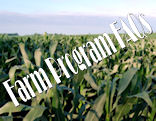September 30, 2009

FAQ: How does USDA’s new Conservation Stewardship Program compare to the previous CSP?
Answer: Provided by Mike Duffy, Iowa State University Extension economist.
USDA began a continuous signup for its newly revamped Conservation Stewardship Program on Aug. 10, with the first signup period cutoff set for Sept. 30. CSP is a voluntary program that encourages farmers and forestry producers to maintain existing soil and water conservation practices and adopt additional ones in their operations.
The idea is to reward farmers with incentive payments for using NRCS-approved, environmentally-friendly practices.
USDA has issued estimated CSP payment ranges based on projected enrollment and performance. The estimate is from $12 to $22 per acre of cropland and $7 to $14 an acre of pastureland. These are the ranges NRCS might issue annually to those farmers who contract with USDA to participate in the new CSP. NRCS officials caution that these projections are only intended as estimates.
There really isn’t any way to be definitive in what the payments will be until after the farmer sits down with NRCS and until all the information is sent to Washington.
New CSP is different than previous CSP
The new CSP is authorized by the 2008 Farm Bill. Congress created the CSP in the 2002 Farm Bill and called it the Conservation Security Program. In the 2008 Farm Bill they gave it a new name—it’s now the Conservation Stewardship Program—and they made major changes in the program.
One major change is that the new CSP is available to all producers nationwide. The old CSP was only available in selected watersheds chosen by USDA for each sign-up period. The new CSP has a continuous signup period which means you can go to the local NRCS office and signup any time. However, applications will be evaluated, ranked and determined whether or not they will be accepted into the CSP by NRCS only during announced signup periods.
For example, if you miss the September 30, 2009 signup deadline for the first ranking period, you can still go to NRCS and signup anytime later and your application will be considered during the next ranking period.
Self-screening checklist saves time
To apply for the new CSP, potential participants are encouraged to use a self-screening checklist first. That will determine whether the new program is suitable for them and their farming operation. The checklist is available online at www.nrcs.usda.gov/new_csp and at NRCS field offices. This self-screening can save some time for people who might be interested in applying for the CSP.
After self-screening, the producer’s current and proposed conservation practices are entered into a conservation measurement tool (CMT). This tool estimates the level of environmental performance to be achieved by a producer in implementing and maintaining conservation activities. The conservation performance estimated by the CMT will be used by NRCS to evaluate and rank applications.
Criteria used for acceptance into CSP
Priority resource concerns are one of the criteria that will be used to rank applications. Iowa’s priority resource concerns include soil quality, soil erosion, water quality and animals—livestock and wildlife. NRCS field staff will also conduct on-site field verifications of applicants’ information obtained from the CMT.
Once the potential participant has been field-verified and approved for funding, he or she must develop a conservation stewardship plan. For information about CSP, including eligibility requirements visit www.nrcs.usda.gov/new_csp and your local NRCS office if you have questions.
CSP contracts are for a 5-year period
In general, there are two payments with the new CSP. The first is an annual payment for adding or continuing existing conservation activities. These appear to be broadly defined to include reduced tillage, grassed waterways, stream bank protection, etc. The payment will be based on conservation payment points for each operation.
A second payment is a supplemental payment for adopting a resource-conserving crop rotation.
The CSP contract is for five years, and a producer has to show control of the land for at least this five years. Also, all the eligible land for the producer’s entire farming operation has to be included. All of the usual USDA payment limits, compliance and other provisions will apply. The total CSP payment limit is $40,000 per year or $200,000 during any 5-year period.
If you have specific questions or need details regarding USDA farm programs, contact your local USDA Farm Service Agency office. You can also get news and information about DCP, ACRE and other USDA programs at www.fsa.usda.gov.
Two Iowa State University Extension Web sites have farm program information and analysis. They are ISU's Ag Decision Maker site at www.extension.iastate.edu/agdm and ISU Extension Specialist Steve Johnson's site at www.extension.iastate.edu/polk/farmmanagement.htm.
And be sure to read the regular column "Frequently Asked Questions about the Farm Program" that appears in each issue of Wallaces Farmer magazine and at www.WallacesFarmer.com
You May Also Like




